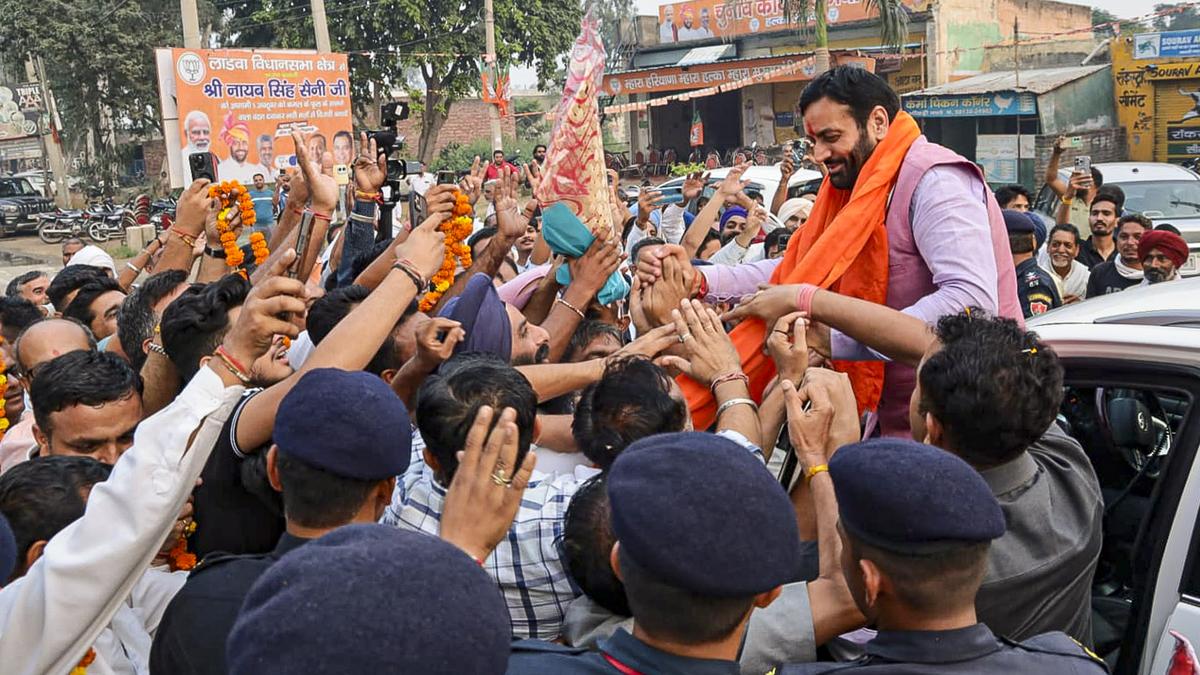Haryana Chief Minister Nayab Saini greets supporters after winning the Assembly elections from Ladwa constituency, at Ladwa, in Kurukshetra district, Haryana.
| Photo Credit: PTI
The Bharatiya Janata Party (BJP) clinched a third term in Haryana in the 2024 Assembly elections, giving a jolt to its key challenger, the Congress. By winning 48 constituencies and pushing all the smaller players out of the main contest, the BJP got a clear majority in the 90-member Assembly. In contrast, despite increasing its vote share from 2019, the Congress was able to win only 37 seats.
After being in power for 10 years in the State, the BJP faced a spirited opposition. The BJP led a silent but focused campaign on the ground, while the Congress was overconfident, which led to its undoing. Other regional players were pushed to the political periphery and limited to minor pockets.
The Lokniti-Centre for the Study of Developing Socities (CSDS) survey, conducted around the time of the elections, provides important insights that help explain the verdict. Six factors seem to have played key roles in shaping the verdict.
The BJP’s advantages
First, overall satisfaction with the incumbent government helped the BJP retain power. Close to six of every 10 respondents in the Lokniti-CSDS survey said they were satisfied with the performance of the BJP State government. Only four of every 10 were dissatisfied. The net satisfaction with the government was 20 percentage points. Three-fourths of those who were fully satisfied with the incumbent government voted for the BJP. On the other hand, three-fourths of those who were fully dissatisfied with the BJP government in the State said they preferred the Congress. Those who were not so unequivocal in their support or unhappiness with the government were equally divided in their support for the two parties.
Second, respondents underscored the importance of the party while deciding who to vote for. More than six of every 10 respondents said that the party was a key factor in determining their vote. The leadership factor played an important peripheral role. The most preferred chief ministerial candidates were the leading faces of the two parties. Incumbent Chief Minister Nayab Singh Saini from the BJP was marginally ahead of former Chief Minister Bhupinder Singh Hooda from the Congress as the preferred choice of Chief Minster. The Narendra Modi factor had some salience in propelling support for the BJP. A similar trend was not seen in the case of Congress leader Rahul Gandhi.
Third, the BJP had two Chief Ministers during its 10 years in power. The incumbent Chief Minister had been in power for just over six months. Yet, when asked to rate the Saini government against the previous Manohar Lal Khattar government, there was higher appreciation (by 10 points) for the work done by Mr. Saini than for Mr. Khattar.
When asked which party was better for farmers’ welfare and development, the respondents gave a higher score to the BJP than the Congress. However, when the responses were filtered to focus on farmers, they believed that the Congress was better at safeguarding their interests. The beneficiaries of welfare schemes for farmers largely voted for the BJP; the Congress was only able to garner significant support among those who were non-beneficiaries.
On the running battle that wrestlers from the State had with the then president of the All India Wrestling Federation, Brij Bhushan Sharan Singh, a majority of the respondents felt that the BJP government at the Centre had taken appropriate action to deal with the issue. The ‘pehelwan’ (fighters) issue figured in the run-up to, and during, the campaign. Yet, it did not seem to have any substantial impact on the ground.
The fourth factor was the women’s vote. The BJP did better than the Congress in securing the support of women. Importantly, half of those who felt that the safety of women had improved in Haryana in the last five years voted for the BJP. Among those who felt that the situation on women’s’ safety has worsened, close to half voted for the Congress.
Fifth, there has always been a Jat-non Jat divide in Haryana politics. The Congress tried to consolidate the Jat vote in its favour. While it did secure a majority of the Jat vote, there were two corollary developments. The Indian National Lok Dal (INLD) was able to garner a chunk of the Jat vote too, thus splitting the vote that the Congress was hoping to fully consolidate. More importantly, the attempt at Jat consolidation led to a stronger non-Jat consolidation behind the BJP. The BJP strengthened its base among the Brahmins, Punjabi Khatris, Yadavs, and non-Jatav Scheduled Castes. This new rainbow coalition was able to work to the party’s advantage.
Congress’s woes
Finally, infighting within the Congress’s State unit appeared to have cost it dearly. The leadership tussle between Mr. Hooda and Kumari Selja appeared to have impacted the party’s performance. Close to six of every 10 respondents asserted that this tussle and its wider ramifications dented the prospects of the party. Only one-fourth of the respondents felt that this factor was not of much consequence in influencing voter choice. Thus, the overconfidence in the Congress, seen throughout the campaign, and the infighting within the party helped the BJP retain the State.
Overall, a better vote-seat conversion appeared to have allowed the BJP to snatch victory from the jaws of defeat. This was possible because the much-anticipated anti-incumbency was rather limited and also because the BJP was able to outsmart the Congress through its ability to craft a coalition of voters with an advantage among women and the non-Jat sections.
Sandeep Shastri is Director-Academics, NITTE Education Trust, and National Coordinator of the Lokniti Network; Suhas Palshikar taught political science and is chief editor of Studies in Indian Politics; and Sanjay Kumar is Professor and Co-director Lokniti-CSDS
Published – October 10, 2024 03:03 am IST
